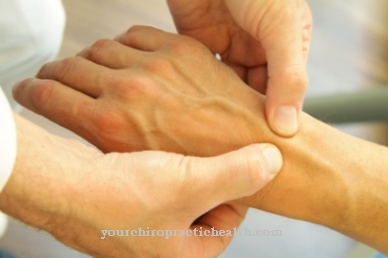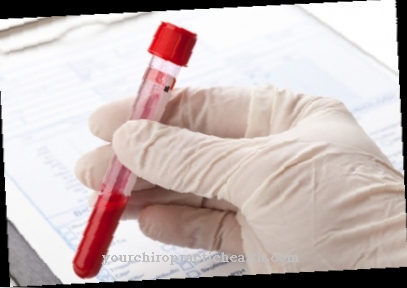The Dynamic hip screw (DHS) is a metal plate and screw construction that is attached to the femur. This procedure is one of the various methods of osteosynthesis that rejoins broken bones with the help of materials that have been introduced.
What is the dynamic hip screw?
A femoral neck fracture is repaired with an operation that preserves the femoral head. There are different therapeutic approaches, but plates and nails are the most common. A disadvantage is that with most procedures the patient has to relieve the operated leg for three months and is restricted in his movement.
Plates and nails are mainly used by young people who have had an accident or fall. In order to restore the patient's mobility as quickly as possible, a construction consisting of a dynamic hip screw and a side plate is placed on the femoral neck.
Function, effect & goals

The dynamic hip screw is a construction that consists of a metal plate and a screw. It is an implant that stabilizes fractures near the hip joint. The most common use is for femoral neck fractures and thigh fractures near the hip (petrochanteric fracture).
The heart of the dynamic hip screw is a femoral neck screw that stabilizes the fracture. A metal plate fixes the hip joint on the outside of the bone shaft. It is attached distally, towards the end of the bone near the knee and fixed to the bone shaft with four screws or nails. At the upper end of the plate near the hip, an angled sleeve is inserted into the femoral neck so that the femoral neck screw can slide back and forth along this sleeve. After the fracture has been repositioned (in the direction), the dynamic hip screw is fastened via an incision approximately 10 centimeters long on the thigh bone.
The difference to the gamma nail method, which is also frequently used, is that the fracture is stabilized by a metal plate attached to the outside of the bone shaft, while the gamma nail is stabilized by an intramedullary nail located inside the bone. The dynamic hip screw works with the sliding mesh principle. The screw shaft can slide inside the plate cylinder, which ensures dynamic compression. The operation is performed on an extension table. The fractured leg is held in place by a leg holder and counter-tension rod. The patient is well padded, paying particular attention to the areas of the body that are at risk of pressure, the pubic area (counter-tension bar) and the ankles. The arm on the side to be operated on is held by an anesthesia clamp in order to avoid nerve damage.
The basic set of instruments includes scalpels, 2 wide sprays, 2 narrow spritzers, 2 long basin hooks, 2 roux hooks, 2 sharp hooks as 5-prongs, reduction forceps and bone scrapers (raspatory). The surgical tools include a target device with a T-handle, threaded guide wires, a three-step drill, a thread cutter, a key with a centering sleeve, a cylindrical guide shaft with a connecting screw, connecting screws, a hammer, a 3.2 mm neutral drill sleeve and a 3.2 mm mm drill bit used. The operating area is covered with four sterile sheets. After the skin incision below the protruding bone on the thigh (greater trochanter), sharp hooks are used for preliminary preparation in order to open the surface (facie).
In this way, the surgeon exposes the thighbone (femur) according to the principle of the so-called “rear letterbox access”. Then the sharp hooks are removed again. In the next step, the threaded guide wire is inserted into the femoral neck using the image intensifier control and a 135 degree aiming device. The measuring gauge provides information on how long the wire has to be in the bone (lateral cortical joint). A 10 mm screw is required. The three-step drill is adapted to the length of the screw, that is, the 10 millimeter screw length must be removed when setting the drill length. The screw ends 10 millimeters from the joint. The DHS screw channel is drilled out. In the first stage the channel for the femoral neck screw is opened, in the second stage the drilling for the part of the plate cylinder takes place.
In the third stage, the head space is milled to connect the cylinder and plate. Only in the case of very hard cancellous bone is a thread cut using a T-handle with a centering sleeve and thread cutter. The dynamic hip screw is assembled using the cylindrical guide shaft, the centering sleeve and the connecting screw. At this point, the guide wire is removed again, the plate holes filled, the measured screws (cortex) inserted and then manually tightened. The image converter control is carried out at all levels. The wound cavity is rinsed out and a Redon drainage is carried out.
In the last step, atraumatic wound closure in layers and a sterile wound dressing with compresses take place. The dynamic hip screw allows a collapse at the fracture site. In combination with a side plate, it ensures maximum hold on the outer part of the thigh bone. However, experts are of the opinion that the ability to rotate could still be improved. Another therapy option is the multiple screw connection, which, however, allows only a slight lateral hold of the fracture. Doctors see the Targon FN implant as the best solution that combines the advantages of dynamic and multiple screw connections.
Risks, side effects & dangers
With the dynamic hip screw, the operated leg can and should be able to withstand full load in a timely manner. The primary goal is to preserve the femoral head joint in order to avoid follow-up operations, especially at a young age.
In contrast to the gamma nail procedure, there is no flushing out of fat, which can lead to fat embolism in older patients with lung damage. The intramedullary nail inside the bone protects the sensitive bone tissue and the periosteum. This gentle procedure is less common with the dynamic hip screw. Therefore, the multiple nail or screw DHS procedure is not recommended for patients with severe osteoporosis. There is a risk of another fracture due to the metal plate and fastening screws attached to the femoral shaft.



























